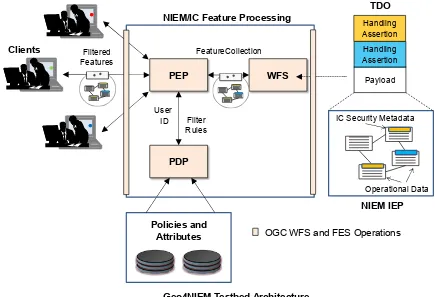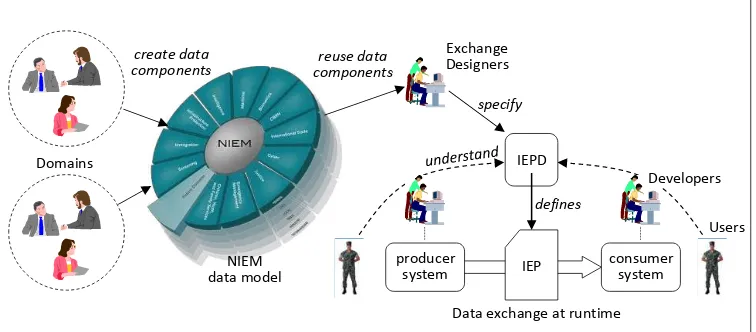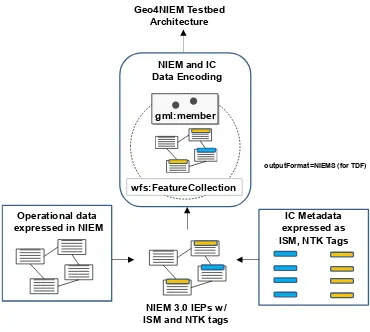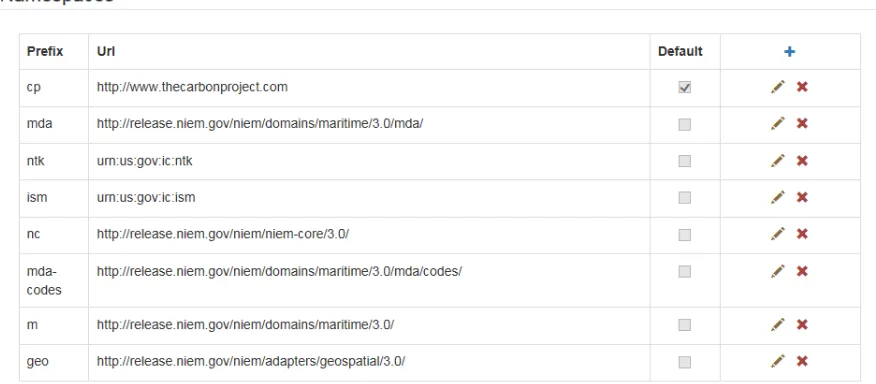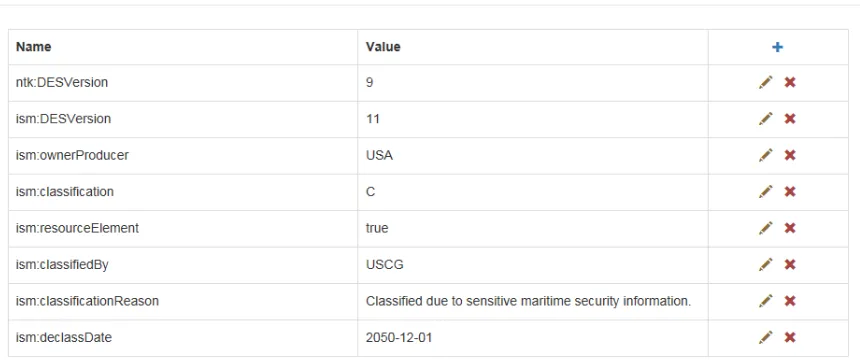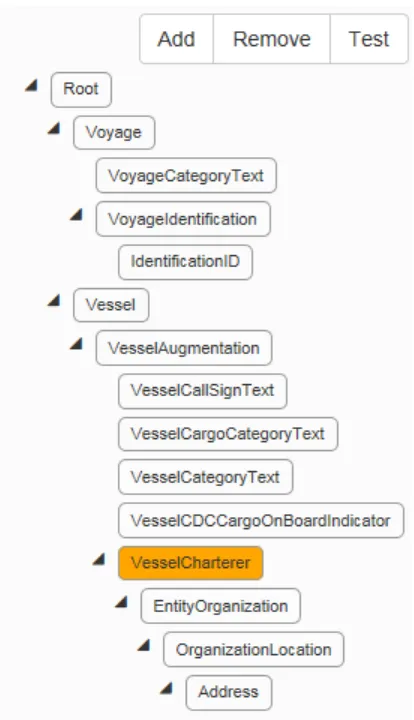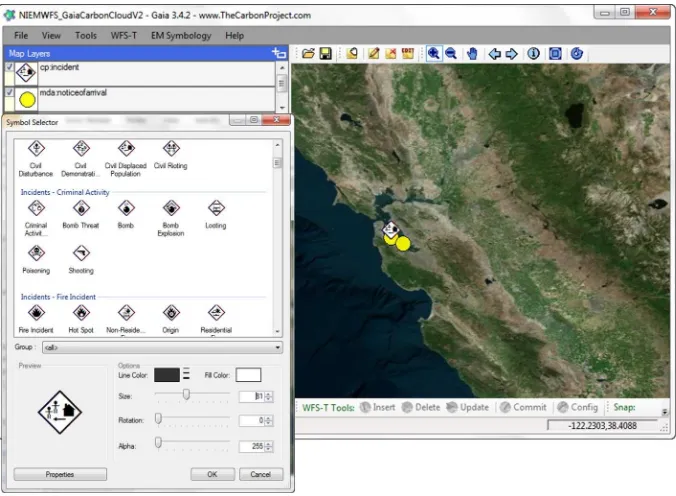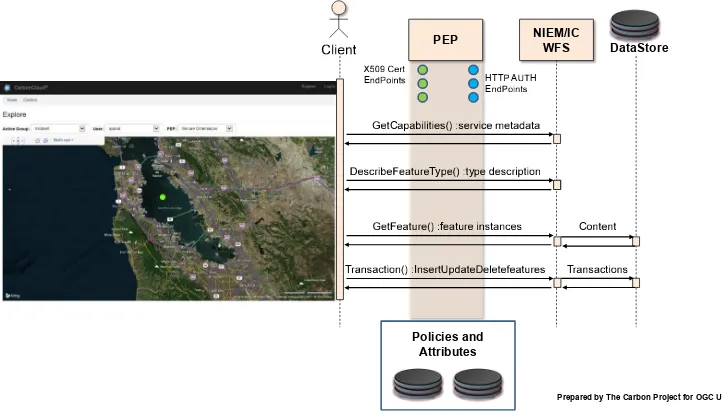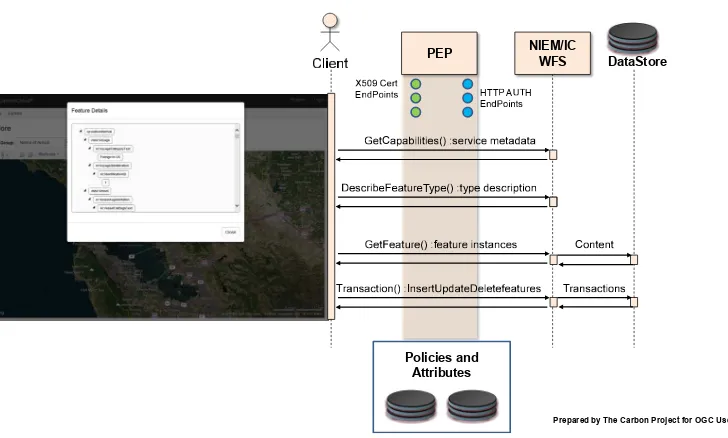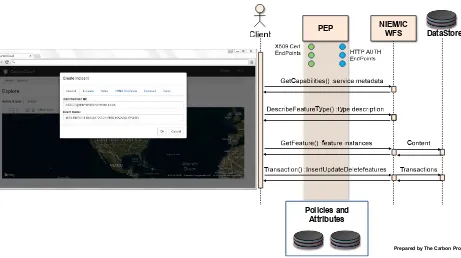Open Geospatial Consortium
Publication Date: 2016-01-25 Approval Date: 2015-09-17 Posted Date: 2015-10-13
Reference number of this document: OGC 15-048r3
Reference URL for this document: http://www.opengis.net/doc/PER/t11-niem-encoding
Category: Public Engineering Report
Editor(s): Jeff Harrison
OGC Testbed-11 NIEM & IC Data Encoding Specification
Assessment and Recommendations Engineering Report
Copyright © 2016 Open Geospatial Consortium.
To obtain additional rights of use, visit http://www.opengeospatial.org/legal/.
Warning
This document is not an OGC Standard. This document is an OGC Public Engineering Report created as a deliverable in an OGC Interoperability Initiative and is not an official position of the OGC membership. The ER is distributed for review and comment. This ER is subject to change without notice and may not be referred to as an OGC Standard. Further, any OGC Engineering Report should not be referenced as required or mandatory technology in procurements.
Document type:
OGC
®Engineering Report
Document subtype:NA
Contents
Page
1
Introduction ... 1
1.1
Scope ... 1
1.2
Participating organizations ... 4
1.2.1
Sponsoring Organizations ... 4
1.2.2
Participating Organizations ... 4
1.3
Document contributor contact points ... 4
1.4
Future work ... 5
1.5
Foreword ... 5
2
References ... 5
3
Terms and definitions ... 6
3.1
Abbreviated Terms ... 7
4
Encoding Development ... 8
4.1
IC Data Encoding & Service Specifications ... 10
4.1.1
XML Data Encoding Specification for Information Security Marking
(ISM) Metadata ... 10
4.1.2
XML Data Encoding Specification for Need-To-Know (NTK) Metadata ... 10
4.1.3
XML Data Encoding Specification for Trusted Data Format (TDF) ... 11
4.1.4
IC Enterprise Attribute Exchange Between IC Attribute Services Unified
Identity Attribute Set (UIAS) ... 13
4.2
NIEM 3.0 ... 13
4.3
Web Feature Service (WFS) ... 14
4.4
Encoding Principles ... 15
4.5
Encoding ... 16
4.5.1
wfs:FeatureCollection ... 16
4.5.2
Namespaces ... 18
4.5.3
ISM and NTK Attributes ... 18
4.5.4
Nested Properties ... 20
4.5.5
Unrestricted Schema ... 23
4.5.6
outputFormat ... 23
4.5.7
Schema Description ... 23
4.5.8
Tags and Roles ... 23
5
Examples of NIEM/IC Data Encoding in Use ... 24
5.1
The Carbon Project ... 27
5.2
Secure Dimensions ... 28
5.3
Con terra ... 29
5.4
Jericho Systems ... 30
6.1
Combining NIEM, IC security, and OGC Web Services is feasible ... 32
6.2
Extra effort relative to typical use of Simple Features profile ... 33
6.2.1
Complex non-spatial properties ... 33
6.2.2
Multiple namespaces, and DescribeFeatureType ... 34
6.2.3
Context-dependent value references in Filter Encodings ... 35
6.3
Simplifying use of NIEM and IC security and meeting exchange needs ... 36
Annex A Sample IEP Instance Document with Security Tags ... 38
Annex B NIEM/IC WFS - wfs:FeatureCollection Sample ... 48
Annex C OutputFormat for Security Info Sample ... 55
Annex D: Revision history ... 63
Figures
Page
Figure 1 – Geo4NIEM Testbed Architecture ... 9Figure 2 - The NIEM Process ... 14
Figure 3 – Converting NIEM IEP with ISM/NTK tags into wfs:FeatureCollections ... 15
Figure 4 - Namespaces for the NIEM/IC Data Encoding on WFS (Notice of Arrival) ... 18
Figure 5 – ISM and NTK attributes for the NIEM/IC Data Encoding on WFS (Notice of Arrival) ... 19
Figure 6 – Nesting for VesselCharterer Component ... 20
Figure 7 – Incident and Notice of Arrival content from The Carbon Project NIEM/IC WFS in Gaia ... 27
Figure 8 - Web Client from The Carbon Project accessing NIEM/IC Data Encoding from Secure Dimensions, con terra and Jericho Systems PEP ... 28
Figure 9 - Secure Dimensions PEP in The Carbon Project web client ... 28
Figure 10 - Secure Dimensions PEP in The Carbon Project web client, feature detail displayed ... 29
Figure 11 – con terra PEP in The Carbon Project web client, executing WFS Transactions ... 30
Figure 12 – Jericho Systems PEP in The Carbon Project web client, accessing Resource encoding ... 31
Abstract
The goal of the Geo4NIEM thread in Testbed 11 was to gain Intelligence Community
(IC) concurrence of the National Information Exchange Model (NIEM) Version 3.0
architecture through the development, implementations, test, and robust demonstration
making use of IC specifications, Geography Markup Language (GML), and NIEM in a
simulated “real-world” scenario. The demonstration scenario begins with
NIEM-conformant Information Exchange Packages (IEPs) containing operational data and IC
security tags from the Information Security Marking (ISM) and Need-To-Know (NTK)
access control metadata, and the Trusted Data Format (TDF) for binding assertion
metadata with data resource(s). Those instance documents are deployed on Open
Geospatial Consortium (OGC) Web Services to be used by client applications. Access
control is based on attributes of the end-user and the instance data.
Recommendations to update these information exchanges were provided to reflect NIEM
3.0 architecture and security tags in a ‘NIEM/IC Data Encoding’. The assessment
exercised this data encoding in OGC Web Feature Services (WFS) and Policy
Enforcement Points (PEP) accessed by multiple client applications. Results from this task
provided a preliminary architecture that was tested and demonstrated in Testbed 11, and
summarized in other OGC Testbed 11 Engineering Reports.
Business Value
Geospatial information technologies are increasingly a foundation for supporting
homeland security, law enforcement, emergency management, and public safety missions
in the U.S. While these technologies rely upon much of the same data, they are typically
developed in silos within a specific mission area. As a result, data duplication and data
exchange delays occur.
In addition, many mission partners have developed stand-alone geospatial information
systems (GIS) or Common Operating Picture (COP) /Situational Awareness (SA)
applications to support their stakeholder communities during incidents and for daily
operational support. While different missions, these GIS or COP/SA capabilities rely
upon much of the same data or generate specific data during an event. The data are often
stove-piped and not exposed to a broader community that could benefit from these data,
resulting in duplication and delayed or incorrect decisions. While mission partners do not
need to use the same GIS or COP/SA tools, they could benefit from shared access to the
common operating data and services used within these systems if they were exposed and
exchanged using open standards.
NIEM’s geospatial exchange capabilities to improve inter-government information
sharing. Validating and testing the NIEM (Version 3.0) technical architecture related to
the IC Data Encoding Specifications (i.e. security tags such as ISM, NTK, and TDF),
aligned to OGC Web Services was identified as a need. Specifically, if the framework’s
geospatial exchange capability is enhanced with security and standards issued by the
OGC it will significantly improve inter-government information sharing.
Keywords
OGC Testbed-11 NIEM & IC Data Encoding Specification
Assessment and Recommendations Engineering Report
1
Introduction
1.1 Scope
The focus of the Geo4NIEM thread in the OGC Testbed 11 was to assess the potential for
security tagging and access control from Intelligence Community (IC) Data Encoding
Specifications to be combined with NIEM for information exchange. The purpose was to
determine if the current NIEM architecture can be aligned with the IC Data Encoding
Specifications, which include (but are not limited to) ISM, NTK and TDF. This
alignment would enable secure information exchange and enhance user/developer
understanding. The assessment included review of real world data exchanges defined in
the form of a NIEM Information Exchange Package Documentation (IEPD). A number of
Extensible Markup Language (XML) instance documents from those real-world
exchanges, populated with operational data and IC security tags, were deployed using
standards enabled OGC Web Services for testing.
This effort builds on the previous work of the Geo4NIEM Pilot Project. Much of the
work was focused on the GML (ISO 19136) data exchange standard and the mechanisms
by which GML and NIEM data could be intermingled. A key driver was to clarify how
data conforming to one framework could be included or “embedded” in the other using
various encapsulation strategies. A secondary goal was to conduct various software
demonstrations in order to assess the feasibility of the various approaches and to explore
the prospects for making use of fundamental OGC web services such as WFS.
Based on the results of the Geo4NIEM Pilot the sponsors of the Geo4NIEM thread in the
Testbed worked with OGC staff to articulate specific functional requirements in order to
meet the following objectives:
Validating the NIEM (Version 3.0) technical architecture related to the IC Data
Encoding Specifications (i.e. ISM, NTK, and TDF) aligned to OGC Web
Services, Phase 9 (OWS-9) Testbed related work.
Testing and demonstrating use of an application programming interface (API) for
operating primarily on GML feature representations leveraging NIEM
components; features may be searched, retrieved, inserted, updated, and deleted.
Reviewing and documenting recommendations to enable full round tripping from
NIEM-conformant information exchange to Geography Markup Language (GML) feature(s) and
back to NIEM-conformant information exchange.
To accomplish these objectives, five primary tasks were identified:
Task 1:
NIEM & IC Data Encoding Specification Assessment and Recommendations
This task assessed the potential for security tagging and access control from the IC Data
Encoding Specifications to be leveraged with NIEM in support of information exchange.
The purpose was to determine if the current architecture of NIEM can support IC
specification alignment. The IC Data Encoding Specifications include but are not limited
to ISM, NTK and TDF metadata.
The assessment included review of real world IEPDs, where the Extensible Markup
Language (XML) schema and NIEM instance documents were populated with relevant
content and IC security tags. IEPDs assessed were:
o
Notice of Arrival IEPD
o
Incidents IEPD
o
Resources IEPD
Recommendations to update these information exchanges were provided to reflect NIEM
3.0 architecture and included sample security and dissemination control markings. The
assessment exercised OGC web services to test NIEM Version 3.0 conformant IEPDs
containing the appropriate IC security markings. Results from this task provided a
preliminary proposed architecture structure that was tested and demonstrated in Task 2.
This task produced one document:
o
Testbed 11 NIEM IC Data Encoding Specification Assessment and
Recommendations ER
Task 2:
NIEM & IC Data Encoding Specification Test and Demonstration
Demonstration of the recommended architecture leveraging the results of Testbed 9 and
previous Geo4NIEM initiatives where appropriate. Results of this task provided updates
to the proposed architecture prepared in Task 1.
Results of this test and demonstration were documented in an Engineering Report
containing the Findings and Recommendations with reference to refinements to the
originally proposed architecture prepared in Task 1.
This task produced one document:
o
Testbed 11 Results of Test and Demonstration of NIEM Using IC Data Encoding
Specifications ER
Task 3:
NIEM-GML-NIEM Round-trip Assessment and Recommendations
This task assessed the NIEM and GML support for geospatial data exchange round-trip
workflow process to include: creation, transfer, receipt, modification, return, and
acceptance of XML content originating as NIEM IEPDs.
This task produced one document:
o
Testbed 11 NIEM-GML-NIEM Round Trip Assessment and Recommendations
ER (Preliminary)
Task 4:
NIEM-GML-NIEM Round-trip Test and Demonstration
This task used the findings and recommended architecture structure supporting
NIEM-GML-NIEM round-trip assessment identified in Task 3 and performs a Test and
Demonstration of the recommended architecture.
This task produced one document:
o
Testbed 11 NIEM-GML-NIEM Round Trip Assessment and Recommendations
ER (Final)
Task 5:
Test and Demonstration of an API for Processing GML Feature Representations
This task produced one document:
o
Testbed 11 NIEM-GML Feature Processing API using OGC Web Services ER.
1.2 Participating organizations
1.2.1 Sponsoring Organizations
Geo4NIEM in Testbed 11 was sponsored by the following organizations:
o
US Department of Homeland Security (DHS)
1.2.2 Participating Organizations
The following organizations played one or more roles in Geo4NIEM in Testbed 11 as
participants (i.e. responded to the RFQ/CFP)
o
The Carbon Project
o
Secure Dimensions
o
con terra
o
Jericho Systems
This document also integrates comments and content from MITRE and Safe Software.
1.3 Document contributor contact points
The following participants (listed in alphabetical order by surname) made substantial
contributions to the content of this report. All questions regarding this document should
be directed to the editor or any of the contributors.
Name Organization
Jan Drewnak con terra
Rüdiger Gartmann con terra
Dean Hintz Safe Software
Andreas Matheus Secure Dimensions
Mark Mattson The Carbon Project
Scott Renner MITRE
Tim Schmoyer Jericho Systems
Many thanks are extended to the reviewers who submitted comments over the course of
the project.
1.4 Future work
Improvements in this document are desirable and will be included based on ongoing
interoperability engineering activities
.
1.5 Foreword
Attention is drawn to the possibility that some of the elements of this document may be
the subject of patent rights. The Open Geospatial Consortium shall not be held
responsible for identifying any or all such patent rights.
Recipients of this document are requested to submit, with their comments, notification of
any relevant patent claims or other intellectual property rights of which they may be
aware that might be infringed by any implementation of the standard set forth in this
document, and to provide supporting documentation.
2
References
The following documents are referenced in this document. For dated references,
subsequent amendments to, or revisions of, any of these publications do not apply. For
undated references, the latest edition of the normative document referred to applies.
Intelligence Reform and Terrorism Prevention Act of 2004
(IRTPA)
Guidelines and Requirements in Support of the Information Sharing
Environment
, Presidential Memo, December 2005.
Open Geospatial Consortium (OGC), Summary and Recommendations of the
Geospatial Enhancement for the National Information Exchange Model
(Geo4NIEM) Interoperability Program Pilot
Open Geospatial Consortium (OGC), Geography Markup Language (GML)
Encoding Standard (
http://www.opengeospatial.org/standards/gml
)
Open Geospatial Consortium (OGC), Web Feature Service (WFS)
(
http://www.opengeospatial.org/standards/wfs
)
Open Geospatial Consortium (OGC), Filter Encoding Implementation
Specification (http://www.opengeospatial.org/standards/filter )
Intelligence Community (IC) Data Encoding Specifications
(
http://www.dni.gov/index.php/about/organization/chief-information-officer/ic-cio-enterprise-integration-architecture
)
IC Enterprise Authorization Attribute Exchange between IC Attribute Services,
Authorization Attribute Set
(
http://www.dni.gov/index.php/about/organization/chief-information-officer/idam-authorization-attribute-set
)
XML Data Encoding Specifications for Information Security Marking Metadata
(
http://www.dni.gov/index.php/about/organization/chief-information-officer/information-security-marking-metadata
)
XML Data Encoding Specification for Need-To-Know Metadata
(
http://www.dni.gov/index.php/about/organization/chief-information-officer/need-to-know-metadata
)
XML Data Encoding Specification for Trusted Data Format
(
http://www.dni.gov/index.php/about/organization/chief-information-officer/trusted-data-format
)
NIEM Version 3.0 (
http://release.niem.gov/niem/3.0
)
NIEM.gov (
http://www.niem.gov
)
Open Geospatial Consortium (OGC),
Web Services Common Standard
(
http://www.opengeospatial.org/standards/common
)
NOTE The OWS Common Standard contains a list of normative references that are also applicable to this Implementation Standard.
In addition to this document, this report includes several XML Document files as
specified in Annexes A and B.
3
Terms and definitions
3.1 Abbreviated Terms
ABAC
Access Based Access Control
AIXM
Aeronautical Information Exchange Model
ARH
Access Rights and Handling
DES
Data Encoding Specification
EDH
Enterprise Data Header
GML
Geography Markup Language
HTTP
Hypertext Transfer Protocol
HTTPS
Hypertext Transfer Protocol over SSL/TLS
IC
Intelligence Community
IEP
Information Exchange Package
IEPD
Information Exchange Package Documentation
ISM
Information Security Markings
MDA
Maritime Domain Awareness
NIEM
National Information Exchange Model
NTK
Need to Know
OGC
Open Geospatial Consortium
OWS
OGC Web Services
PDP
Policy Decision Point
PEP
Policy Enforcement Points
PM-ISE
Program Manager for the Information Sharing Environment
RFC
Request For Comments
SSL
Secure Sockets Layer
TDF
Trusted Data Format
TDO
Trusted Data Object
TLS
Transport Layer Security
UAAS
Unified Attribute and Authorization Service
UIAS
Unified Identity Attribute Set
WFS-T
OGC Web Feature Service – Transactional
XLink
XML Linking Language
XML
Extensible Markup Language
4
Encoding Development
For the OGC Testbed 11 Geo4NIEM thread, participants assessed security and
WFS
NIEM IEP
Policies and Attributes Clients
PEP
PDP
NIEM/IC Feature Processing
OGC WFS and FES Operations
Geo4NIEM Testbed Architecture
Prepared by The Carbon Project and MITRE for OGC Use
Operational Data IC Security Metadata
Payload Handling Assertion Handling Assertion
TDO
FeatureCollection
User ID Filter
Rules Filtered
Features
Figure 1 – Geo4NIEM Testbed Architecture 1
For this testbed three information exchange frameworks and encodings were considered:
IC Data Encoding Specifications
NIEM 3.0
OGC Web Services
4.1 IC Data Encoding & Service Specifications
The success of intelligence, defense, homeland security, and law enforcement missions is
dependent on information producers and consumers being able to share, manage,
discover, retrieve, and access information across national and international boundaries.
The IC Data Encoding Specifications (DES) are the result of IC collaboration and
coordination in response to public law, executive orders, policy and guidance, and change
requests submitted by IC elements. Data encoding specifications define agreed upon
digital encodings or formats for information being shared or exchanged within the
enterprise. These specifications should be viewed as component modules. Many of the
specifications are tightly integrated and dependent on each other. They can be integrated
into other data encoding specifications or profiled (i.e., configured or constrained) to
achieve a particular mission or business objective - such as supporting security tagging
within the NIEM.
While this flexibility exists, users of the IC Data Encoding Specifications are required to
maintain conformance to the relevant specification. An instance document is considered
conformant to an IC DES if it passes all of the normative validation steps. The IC DES
XML schemas (unless noted otherwise) CVE values from the XML CVE files, and the
Schematron code version of the constraint rules are normative for the specifications.
4.1.1 XML Data Encoding Specification for Information Security Marking (ISM) Metadata
The XML Data Encoding Specification (DES) for Information Security Markings
(ISM.XML) defines detailed implementation guidance for using XML to encode
Information Security Markings (ISM) metadata. This DES defines the XML attributes,
associated structures and relationships, restrictions on cardinality, permissible values, and
constraint rules for representing electronic information security markings.
4.1.2 XML Data Encoding Specification for Need-To-Know (NTK) Metadata
The XML Data Encoding Specification (DES) for Need-to-Know Metadata (NTK.XML)
defines detailed implementation guidance for using XML to encode metadata necessary
to facilitate automated systems making access control decisions. This DES defines the
XML elements and attributes, associated structures and relationships, restrictions on
cardinality, and permissible values for representing access control data concepts using
XML.
information resource may include multiple occurrences of these metadata in order to
specify access control information according to multiple, different access systems.
4.1.3 XML Data Encoding Specification for Trusted Data Format (TDF)
The XML Data Encoding Specification (DES) for Trusted Data Format (IC-TDF.XML)
defines detailed implementation guidance for using XML to encode IC-TDF data. This
Data Encoding Specification (DES) defines the XML elements and attributes, associated
structures and relationships, mandatory and cardinality requirements, and permissible
values for representing trusted data format data concepts using XML.
The Intelligence Community (IC) has standardized the various classification and control
markings established for information sharing within the Information Security Markings
(ISM), Need-To-Know (NTK), Enterprise Data Header (EDH), and Access Rights and
Handling (ARH) XML specifications of the Intelligence Community Enterprise
Architecture (ICEA) Data Standards. The IC-TDF.XML specification further expands on
this body of work, adapting and extending it as necessary for TDF to function as the IC
submission format for binding assertion metadata with data resource(s). This TDF
functionality supports the IC way-ahead strategy of implementing secure cloud-based
information exchange and discovery on the IC Enterprise
IC-TDF Dependencies2
The IC-TDF.XML specification has a consistent and simple concept of Assertions and
Payloads. There are two options for root elements: Trusted Data Object (TDO) and
Trusted Data Collection (TDC). A TDO contains some data (the payload) and some
statements about that data (the assertions). In the context of TDF, an ‘assertion’ is defined
as a statement providing handling, discovery, or mission metadata describing a payload,
TDO, or TDC, depending on the scope of the assertion. To facilitate handling and access
control decisions, each TDO and TDC must contain at least one Handling Assertion. A
Handling Assertion is a special type of structured assertion that contains the IC Enterprise
Data Header (EDH) for the TDO or payload, providing the attributes needed for policy
decisions regarding access control and how the data must be handled. ISM and NTK
markings are contained in Handling Assertions, as part of the Access Rights and
Handling (ARH) block. Additional discovery and mission assertions may also be
provided. A TDC contains a list of TDOs (the payload) and some statements about those
TDOs (the assertions). A TDC may also be a collection of collections, and contain other
TDCs.
Each TDO consists of one or more assertions and a payload. Assertions may optionally
be cryptographically bound to the payload to provide assurance over the integrity of the
assertion, the payload, and the relationship between the assertion and payload. Each
IC-TDF requires at least one handling assertion, optional discovery and mission assertions,
and a payload. The handling assertion must consist of a structured IC-EDH block.
Mission specific metadata may consist of a structured block (XML) or unstructured data
(binary). The payload may be structured XML, unstructured data, or a reference. A TDC
consists of a collection of TDOs or TDCs. It is expected but not required that the child
TDOs and TDCs within a TDC are in some way related, with relationships encoded in the
TDC assertions.
Information sharing within the national intelligence enterprise increasingly relies on
information assurance metadata to allow interagency access control, automated
exchanges, and appropriate protection of shared intelligence. This requires a structured,
verifiable representation of security metadata bound to the intelligence data in order for
the enterprise to become inherently "smarter" about the information flowing in and
around it. This representation when implemented with other data formats, improved user
interfaces, and data processing utilities, can provide part of a larger robust information
assurance infrastructure capable of automating some of the management and exchange
decisions now requiring human involvement. These specifications are in operational
usage outside of the IC currently for other missions such as Defense and Law
4.1.4 IC Enterprise Attribute Exchange Between IC Attribute Services Unified Identity Attribute Set (UIAS)
NIEM is a standards-based approach to the design of structured information exchange
specifications. Figure 2 illustrates the process, which is described in reverse order (right
to left) as follows: Producer and consumer software applications exchange structured
information in the form of XML documents known as information exchange packages
(IEPs). Developers of that software understand the expected content of those IEPs by
understanding the exchange specification, which in NIEM is called an Information
Exchange Package Documentation (IEPD). The designers of the IEPD follow the NIEM
process, reusing data components from the NIEM data model and extending their
exchange with new components as needed. The NIEM community [3] creates shared data
components for those concepts on which they can agree and for which they believe a
common definition will be useful.
Defining the mandatory minimum set of IC enterprise authorization attributes and values
for sharing through the IC UAAS federation supports consistent and assured information
sharing across the enterprise. The IC UAAS supports Attribute-Based Access Control
(ABAC) to promote on-demand access to information and other resources by IC users
and services, and reduces authorization vulnerabilities by strengthening the access control
decision process.
IC Enterprise Attribute Exchange Between IC Attribute Services Unified Identity
Attribute Set (UIAS) specification is implemented by the OGC Attribute Store to define
the user attributes used for the Testbed 11. While the UIAS specification codifies the
minimum set of enterprise-level authorization attributes that IC elements are expected to
provide if they participate in the Intelligence Community Unified Authorization and
Attribute Service (UAAS) architecture, Testbed 11 applies the specification to state and
local emergency responder participants. These attributes are explicitly used as parameters
for access to the data assets tagged with NTK.XML.
4.2 NIEM 3.0
NIEM is a standards-based approach to the design of structured information exchange
specifications. Figure 2 illustrates the process, which is described in reverse order (right
to left) as follows: Producer and consumer software applications exchange structured
information in the form of XML documents known as information exchange packages
(IEPs). Developers of that software understand the expected content of those IEPs by
understanding the exchange specification, which in NIEM is called an Information
Exchange Package Documentation (IEPD). The designers of the IEPD follow the NIEM
process, reusing data components from the NIEM data model and extending their
An IEPD consists of a minimal but complete set of artifacts (XML schemas,
documentation, sample XML instances, etc.) that defines and describes an implementable
NIEM information exchange. A complete and conforming IEPD will contain all the
schema definitions and instructional material necessary to:
Understand information exchange content, semantics, and structure.
Create and validate information exchanges defined by the IEPD.
Identify the lineage of the IEPD and optionally its artifacts.
consumer
system
IEPD
producer
system IEP
NIEM
data model
Domains
Developers
defines
Users Exchange
Designers reuse data
components
specify
Data exchange at runtime
create data components
Prepared by MITRE for OGC
Figure 2 - The NIEM Process
4.3 Web Feature Service (WFS)
The OGC Web Feature Service (WFS) Implementation Specification allows a client to
retrieve geospatial data encoded in Geography Markup Language (GML) from multiple
Web Feature Services. The standard defines interfaces for data access and manipulation
operations on geographic features, using HTTP as the distributed computing platform.
Via these interfaces, a Web user or service can combine, use and manage geodata -- the
feature information behind a map image -- from different sources. A Transactional Web
Feature Service allows a client to send messages relating to making changes to a
4.4 Encoding Principles
As a first step Trusted Data Objects (TDO) including ISM and NTK metadata in XML
were added to the NIEM IEP documents along with GML feature geometries for testing.
An example of a NIEM/IC Data Encoding with these security tags is provided as Annex
A. The next step in the project was to serve the security-tagged NIEM/IC Data Encoding
through an OGC Web Feature Service – Transactional (WFS-T). This process is
summarized in Figure 3.
A key consideration at this phase in the project was that the modular nature of the NIEM
and IC security tags allows them to be combined in multiple ways to support the needs of
information exchange. Accordingly, the encoding of the NIEM/IC Data Encoding on
WFS needed to be flexible and allow for many different types IEP instance documents as
input. For example, each Homeland Security domain may have many information
exchanges, each with its own IEP documents for data exchange.
gml:member
wfs:FeatureCollection
Operational data expressed in NIEM
NIEM 3.0 IEPs w/ ISM and NTK tags
IC Metadata expressed as ISM, NTK Tags NIEM and IC
Data Encoding Geo4NIEM Testbed
Architecture
outputFormat=NIEMS (for TDF)
To support this flexibility, guiding principles were applied to the development of the
NIEM/IC Data Encoding. For example, it must support multiple namespaces and
complex nested schema. It must also be discoverable, self-describing and support
interactive query and update. Finally, it must support multiple security tagged IEP
instance documents. The OGC Web Feature Service – Transactional (WFS-T) was
selected as a template to test the NIEM/IC Data Encoding since it supports all these
principles.
Using these principles and WFS-T as a template, the project assessed two ways of
delivering the data encoding:
NIEM IEP containing ISM and NTK metadata as a member of
wfs:FeatureCollection (called the ‘NIEM/IC WFS’)
NIEM IEP with ISM and NTK metadata, appearing as the structured payload in a
TDO, which in turn is a member of wfs:FeatureCollection. (This encoding was
made available via the outputFormat parameter called ‘NIEMS’)
This approach provided the NIEM/IC WFS as a default option since it was assessed this
model may be more readily handled by server and client applications during initial
testing. Three IEPs were converted, Notice of Arrival, Incident and Resource, into
NIEM/IC wfs:FeatureCollection and tested during hands-on collaborative engineering.
From that engineering a set of candidate rules were developed to guide the development
of NIEM/IC Data Encoding in an environment where there may be hundreds of potential
IEP instance documents, each with security tags. These rules are summarized in the
following sections.
4.5 Encoding
To support testing of the NIEM/IC Data Encoding a cloud-based test environment was
established by The Carbon Project. PEPs from multiple Participants including Secure
Dimensions, con terra and Jericho Systems then accessed the NIEM/IC Data Encoding on
the cloud-based test environment. Hands-on collaborative engineering yielded the
following set of parameters to guide the development of NIEM/IC Data Encodings.
4.5.1 wfs:FeatureCollection
This encoding tested NIEM/IC Data Encoding as an XML document with a root element,
wfs:FeatureCollection for information exchange. The wfs:FeatureCollection contained 1
or more gml: featureMembers representing geographic features. A
summary
<wfs:FeatureCollection <gml:featureMember> <mda:noticeofarrival …
…
</mda:noticeofarrival> </gml:featureMember> <gml:featureMember> <mda:noticeofarrival …
…
</mda:noticeofarrival> </gml:featureMember> </wfs:FeatureCollection>
A complete example wfs:FeatureCollection with a single gml:featureMembers from the
prototype the NIEM/IC Data Encoding is included as Annex B. For Geographic Features
as wfs:FeatureCollection the version of GML that shall be supported is ISO 19136:2007.
The use of the term gml:featureMember is based on the designation provided for in
NIEM 3.0. This designation may be slightly different based on the Version of OGC WFS
Specification implemented.
Data exchange implementing this encoding provided structured content
as NIEM 3.0 within awfs:FeatureCollection. A summary representation of a wfs:FeatureCollection
with NIEM 3.0 mda:noticeofarrival content is provided below.
<wfs:FeatureCollection <gml:featureMember> <mda:noticeofarrival
<mda:Voyage ownerProducer="USA" classification="U"> <m:VoyageCategoryText>Foreign to
US</m:VoyageCategoryText>
<m:VoyageIdentification>
<nc:IdentificationID>1</nc:IdentificationID> </m:VoyageIdentification>
<mda:VoyageClosedLoopIndicator>false</mda:VoyageClosedLoopIndicat or>
</mda:Voyage> …
…
</gml:featureMember> </wfs:FeatureCollection>
4.5.2 Namespaces
Multiple namespaces are required in a NIEM/IC Data Encoding using WFS, including
NIEM 3.0, IC Data Encoding and OGC. Below is a partial listing of the namespaces for
NIEM/IC Data Encoding development using a sample Notice of Arrival IEP instance
document with security tagging.
Figure 4 - Namespaces for the NIEM/IC Data Encoding on WFS (Notice of Arrival)
4.5.3 ISM and NTK Attributes
Figure 5 – ISM and NTK attributes for the NIEM/IC Data Encoding on WFS (Notice of Arrival)
Data exchange implementing this encoding provided
ism:classification and ntk:Access tags within awfs:FeatureCollection. A summary representation of a wfs:FeatureCollection
with NIEM 3.0 mda:noticeofarrival content and IC
ism:classification and ntk:Access tagsis
provided below.
<wfs:FeatureCollection xmlns:wfs="http://www.opengis.net/wfs" xmlns:gml="http://www.opengis.net/gml"
xmlns:mda="http://release.niem.gov/niem/domains/maritime/3.0/mda/ " xmlns:m="http://release.niem.gov/niem/domains/maritime/3.0/" xmlns:nc="http://release.niem.gov/niem/niem-core/3.0/">
<gml:featureMember> <mda:noticeofarrival
mda="http://release.niem.gov/niem/domains/maritime/3.0/mda/" ntk="urn:us:gov:ic:ntk" ism="urn:us:gov:ic:ism"
nc="http://release.niem.gov/niem/niem-core/3.0/"
mda-codes="http://release.niem.gov/niem/domains/maritime/3.0/mda/code s/" m="http://release.niem.gov/niem/domains/maritime/3.0/"
geo="http://release.niem.gov/niem/adapters/geospatial/3.0/" DESVersion="11" ownerProducer="USA" classification="C" resourceElement="true" classifiedBy="USCG"
classificationReason="Classified due to sensitive maritime security information." declassDate="2050-12-01"
id="noticeofarrival.1" p7="http://www.opengis.net/gml"> <gml:featureMember>
…
</mda:noticeofarrival> </gml:featureMember> </wfs:FeatureCollection>
4.5.4 Nested Properties
Data exchange implementing this encoding provided NIEM wfs:FeatureCollections with
attributes on the featuretype and fields, which may be nested. An example of a Vessel
component is shown below using the CarbonCloud Group Edit tools for NIEM. In this
example, nesting is visible for VesselCharterer and contained components.
A
summary
representation of a wfs:FeatureCollection with nested content for an
<mda:VesselCharterer> component is provided below.
<wfs:FeatureCollection <gml:featureMember> <mda:noticeofarrival …
…
<mda:Vessel ownerProducer="USA" classification="U"> <m:VesselAugmentation ownerProducer="USA" classification="U">
<m:VesselCallSignText>H3LP</m:VesselCallSignText> <m:VesselCargoCategoryText>Harmful
Substances</m:VesselCargoCategoryText> <m:VesselCategoryText>Container Ship</m:VesselCategoryText>
<mda:VesselCDCCargoOnBoardIndicator>true</mda:VesselCDCCargoOnBoa rdIndicator>
<mda:VesselCharterer ownerProducer="USA"
classification="C" access="#Roles|Group^MDA-USCG-Msn-District11-ROC">
<nc:EntityOrganization> <nc:OrganizationLocation> <nc:Address>
<nc:LocationCountryISO3166Alpha2Code>KR</nc:LocationCountryISO316 6Alpha2Code>
</nc:Address>
</nc:OrganizationLocation> <nc:OrganizationName>SK Shipping</nc:OrganizationName>
</nc:EntityOrganization> </mda:VesselCharterer> …
…
</mda:noticeofarrival> </gml:featureMember> </wfs:FeatureCollection>
Data exchange implementing this encoding supported fields which are the same name. In
the summary example below fields named <nc:Date> are structured so the parent
<wfs:FeatureCollection
<m:VesselISSC ownerProducer="USA" classification="C" access="#Roles|Group^MDA-USCG-Msn-District11-ROC">
</m:VesselSafetyManagementCertificate>
… …
4.5.5 Unrestricted Schema
Data exchange implementing this encoding provided schemas for the NIEM and IC Data
Encoding in GML with no restrictions placed on non-spatial properties – equivalent to
those that comply with level two (2) of the OGC Simple Features (SF)for GML Profile..
The spatial properties, however, may be limited to the set of geometric property types
supported by compliance levels SF-0 and SF-1 to support broad adoption in as many
geospatial applications as possible.
4.5.6 outputFormat
Data exchange implementing this encoding may provide additional TDO wrapped
security information for a ‘NIEMS’ wfs:FeatureCollection via WFS outputFormat.
An example of the NIEMS outputFormat is included as Annex C.
4.5.7 Schema Description
Data exchange implementing this encoding can provide a DescribeFeatureType operation
that returns a schema description of feature types offered by a WFS instance. The schema
descriptions define how WFS expects NIME/IC feature instances to be encoded on input
and on output (for example, in response to a GetFeature operation). This model is
described in more detail in a separate ER.
Servers that implemented the NIEM/IC Data Encoding also use the GetCapabilities
operation to generate a service metadata document describing a WFS service provided by
a server. This model is described in more detail in a separate ER.
4.5.8 Tags and Roles
Each document included an <ntk:Access /> tag and various <ntk:AccessGroup /> and
<ntk:AccessGroupValue /> information nested in various tags throughout the rest of the
document. Any tag in the document payload, and all of its children tags could be filtered
from being sent to the client based upon the ntk:access="#Roles|Group^{role list}"
attribute for that tag. These role attributes are specific and need exact pattern match to
allow the tag and its children to pass. More specifically, if a tag has an ntk:access
attribute that does not match exactly the user attribute Role, then that information should
not be sent to the client.
information exchange resources to some users, limited kinds of access to other users, and
completely deny access to yet another set of users.
Each access control rule implemented by a different Policy Enforcement Points (PEP)
grants (or denies) requests made by an individual or group of individuals, possibly
depending on details associated with the request. Referring to one or more web services,
rules can specify, for a given set of users, the conditions under which access is to be
granted to them. A user can be associated with roles within an organization or with a
group whose membership is known throughout the system.
The responsibility for implementing this access control is delegated to the PEP in this
prototype NIEM/IC information exchange. NIEM/IC API responses and response pass
through the PEPs, and each access control rule implemented by different PEPs grants (or
denies) requests made by an individual or group of individuals, depending on the Roles,
ntk:AccessGroups,
ism:classificationand AccessPolicy associated with the user making
the request.
In addition, because rules will refer to user roles and names, security within NIEM/IC
information exchange the test and demonstration implementation provides a way to name
users and mechanisms to manage user identities, including the means by which users can
be authenticated. A person is authenticated and assumes an identity by demonstrating
knowledge of a secret (such as a password), or possession of some other information, that
is associated with that identity.
NIEM/IC information exchange has a flexible authentication framework that supports
multiple authentication methods. This approach allows an organization to use existing
authentication methods. For example, a user might be authenticated at an organization by
providing a username/password (HTTP AUTH) that is recognized in the organization, or
via X.509 certificates.
Key within this test and demonstration implementation is the OGC Attribute Store. The
OGC Attribute Store implements the IC Enterprise Attribute Exchange Between IC
Attribute Services Unified Identity Attribute Set (UIAS) specification. The specification
documents a set of IC enterprise identity attributes and associated values that are required
for participation in Intelligence Community Unified Authorization and Attribute Service
(UAAS) architecture. Information about user and role assignment is stored in an LDAP.
The data can be accessed via the OGC IdP Attribute Service interface.
5
Examples of NIEM/IC Data Encoding in Use
Dimensions, con terra and Jericho Systems. The following examples provide a very brief,
sample overview of the demonstration scenario. For a complete description please see the
Test and Demonstration ER, and the actual Testbed 11 Geo4NIEM Demonstration
The basic flow of events in the demonstration was:
1.
Clients authenticate
3.
2.
Clients issue getCapabilities and getFeature requests to the PEP, which is acting
as a WFS proxy.
3.
The PEP passes a getFeature request to the WFS, receives a featureCollection.
4.
The PEP passes the user identity to the PDP.
5.
The Policy Decision Point (PDP) looks up user attributes and related access
control policies.
6.
The PDP creates a filter rule from the user attributes and access control policies.
The rule is expressed in terms of data attributes; i.e. ISM and NTK security and
access control metadata attributes.
7.
The PDP forwards the filter rule to the PEP.
8.
The PEP applies the filter rule to the featureCollection. Sometimes the rule
completely removes a member from the collection. Sometimes it redacts the
information that is in a collection member.
9.
The filtered featureCollection is returned to the client. Note – the effort
demonstrated two different ways of handing NIEM IEPs that contain embedded
GML data: with and without the TDO wrapper. In both cases the
feature
is the
NIEM IEP. The TDO wrapper is treated as an
output format
.
10.
Based on some user action, the client can send a WFS Transaction operation to
the PEP, which is still acting as a WFS proxy for the WFS server.
11.
The PEP executes authenticate and filtering steps again, this time to see if the
policy permits the user to make the transaction request. The PEP lets the request
pass through or it doesn't.
12.
Based on the WFS-T request, the WFS server updates its internal state.
5.1 The Carbon Project
The Carbon Project implemented the NIEM/IC Data Encoding in an OGC WFS instance
as well as in multiple client applications, including a new web client developed for
Testbed 11. The Web Feature Service (WFS) provided NIEM/IC Data Encoding as
wfs:FeatureCollections to multiple Policy Enforcement Point (PEP) services. In addition,
the WFS provided NIEM/IC Data Encoding directly to client applications such as Gaia
shown below with symbolized Incident wfs:FeatureCollections and Notice of Arrival
content. It should be noted that Gaia represents an older geospatial application. The
Carbon Project also developed new web clients able to access the NIEM/IC Data
Encoding via PEP from Secure Dimensions, con terra and Jericho Systems, and NIEM/IC
WFS from The Carbon Project. An example of this new web client for NIEM/IC is
shown in the second graphic below.
Figure 8 - Web Client from The Carbon Project accessing NIEM/IC Data Encoding from Secure Dimensions, con terra and Jericho Systems PEP
5.2 Secure Dimensions
Examples of the Secure Dimensions PEP and The Carbon Project NIEM/IC web client
are below.
4Cin
GCaa s() semaaa
D se Faue Ty( ) yse r
GFaue ( ) fa ue sas
DataStore
Cr
NIEM/IC WFS
Te as a r( )Ise UaDaue s
PEP
Te as a rs
HTTP A H
E Po t X 5 09 t
E Po t
Prepared by The Carbon Project for OGC Use
Policies and Attributes
Figure 9 - Secure Dimensions PEP in The Carbon Project web client
C !"#$ % & ' *
+ &$ , -$ Ty!"# y * &$ . /
, -$ !"#f -$/ /&
DataStore
C./ /
NIEM/IC WFS
T$ / & ./ !"#I/ $1*+ 2 -$
PEP
T$ / &. /
HTT3 A46H
E783 :; 7<= >? @ABEH<
E7 83:; 7<=
Prepared by The Carbon Project for OGC Use
Policies and Attributes
Figure 10 - Secure Dimensions PEP in The Carbon Project web client, feature detail displayed
5.3 Con terra
con terra implemented the NIEM/IC Data Encoding in PEP services.
5Examples are
provided below.
I JKCLML NOQ OK OJR STVR JWYOZJ[J KL \L KL
]JR ZW O NJ^JLK _WJTyMJS TV KyMJ\JRZ W O MKO`b
I J K^ JL K _WJS TVfJLK _WJObRKLbZJR
DataStore
C`b KJb K
NIEM/IC WFS
TWLbRLZ KO`bS TVIbRJW KcM\LKJ ]JQ J KJdJLK_WJR
PEP
TWLbR LZK O`bR HTTf AghH
Ejkfl p jq v wx y z{| }q
Ejkf lp jq v
Prepared by The Carbon Project for OGC Use
Policies and Attributes
Figure 11 – con terra PEP in The Carbon Project web client, executing WFS Transactions
5.4 Jericho Systems
Jericho Systems implemented the NIEM/IC Data Encoding in PEP services.
6Examples
are provided below.
~C
Ty y
~ f
DataStore
C
NIEM/IC WFS
TI
PEP
T HTT A H
E ¡¢£¤¥
E
Prepared by The Carbon Project for OGC Use Policies and
Attributes
Figure 12 – Jericho Systems PEP in The Carbon Project web client, accessing Resource encoding
6
Findings and Recommendations
The evidence obtained through the Testbed 11:Geo4NIEM thread supports three main
findings:
First, with reasonable effort it is possible to combine NIEM, IC security
specifications, OGC Web Service components, and GML-aware clients to support
information exchange with authorized users.
Second, implementing such an exchange requires extra work, compared to a
typical exchange of features that conform to the GML Simple Features profile.
However, this level of effort is not greater than encodings already in OGC, such
as Aeronautical Information Exchange Model (AIXM), where a community of
interest has defined a standard GML application schema for exchanging
geographic data.
include NIEM IEPD development guidance or recommended practices that reduce
the impact of generating excessive namespaces.
The following sections describe these findings and any associated recommendations.
6.1 Combining NIEM, IC security, and OGC Web Services is feasible
The demonstration used real-world NIEM IEPs, containing embedded GML elements,
properly tagged with IC access control and security metadata, and optionally enclosed
within the IC's dissemination format for binding assertion metadata with data resources
(i.e. IC-TDF.XML/TDO). The demonstration was constructed using a cloud-based WFS
server, multiple Policy Enforcement Points that provide access controls and filters based
upon the user attributes stored in the OGC Attribute Store and multiple GML-aware
clients. Major OGC operations in a simulated distributed information exchange were
assessed including:
WFS server with GetCapabilities, DescribeFeatureType, GetFeature, and
Transaction operations
Access control engines enforcing access policy based on user attributes and IC
metadata attributes in the WFS FeatureCollection payload
Clients interpreting the WFS FeatureCollection elements and performing
transaction operations
NIEM 3.0 was compatible with the IC security, access control and dissemination
specifications (ISM, NTK, and TDF) and supported the access control policies for the
demonstration scenario. There is no evidence to suggest incompatibility with more
complex policies, schemas and security markings. Access control engines can work with
NIEM/IC Data Encoding, with or without a services framework.
The participants spent most of their time learning about the NIEM exchange
specifications and the IC security specifications. Implementation of the second and third
information exchanges (based on Incident and Resource IEPs) took less development
time since specialized tools were created to speed the ‘cloning’ of the first WFS instance
(based on the Notice of Arrival IEP).
In the developed NIEM/IC Data Encoding security attributes were part of the field
definitions. The project team assessed that it makes good engineering sense to structure
the encoding in this manner and that IC security can work successfully within NIEM.
For example, imagine there is a field for personal identifiers (like US SSN).
Recommendation 1: Develop, test and demonstrate tools that clone and adjust data
elements of WFS instances of NIEM/IC Data Encodings to simplify and speed
development and deployment of service-based information exchanges. Assess tools that
promote export of NIEM/IC Data Encodings.
Recommendation 2: Assess how IC security specifications (ISM, NTK, and TDF) may
further enable WFS and GML-based data exchange.
6.2 Extra effort relative to typical use of Simple Features profile
The GML Simple Features profile defines fixed coding patterns for the use of a subset of
XML Schema and GML constructs. It is intended to address the case where a client
interacts with a previously unknown server offering. This is the typical case for many
OWS components. Relative to that typical case, the demonstration implementation for
NIEM/IC Data Encoding required extra effort in three areas: complex non-spatial
properties, multiple namespaces and DescribeFeatureType, and context-dependent value
references in filter encodings.
6.2.1 Complex non-spatial properties
Information exchanges implementing the draft NIEM/IC Data Encoding required
schemas in wfs:FeatureCollections roughly equivalent to those that comply with level
SF-2 for GMLsf. This finding means that some current WFS and GML applications and
services expecting GMLsf Level 0 or 1 tools may not able to fully operate with NIEM/IC
Data Encoding ‘out of the box’. This finding also means that exporting NIEM/IC Data
Encoding from a WFS may not be possible in common GIS formats such as Shapefiles.
The SF-0 profile does not allow complex non-spatial properties. These are permitted but
unusual in the SF-1 profile. This simplicity can be exploited in server and client software,
allowing off-the-shelf components to handle new application schemas with little or no
special effort. However, this simplicity is not present in the NIEM/IC encoding. For
example, the Notice of Arrival IEPD defines a complex property with six levels of nested
elements, resulting in data like this:
<mda:Vessel ...>
<m:VesselAugmentation ...>
<m:VesselCargoCategoryText>Harmful Substances ... <m:VesselCategoryText>Container Ship ...
<m:VesselCDCCargoOnBoardIndicator>true ... <m:VesselCharterer ...>
<nc:EntityOrganization> <nc:OrganizationLocation> <nc:Address>
<nc:LocationCountryISO3166Alpha2Code>KR ... </nc:Address> ...
From the perspective of an Information Exchange designer or implementer, this level of
complexity may require effort in the WFS server implementations when compared with
less extensive SF-0 and SF-1 schemas, especially when implementing the WFS-T
functions. It also requires extra effort in the client applications, where specialized Filter
Encodings using XPath expressions are necessary to retrieve values from the complex
properties.
Recommendation 3: Develop and test a Best Practice
that defines more limited, but useful, subsets of NIEM/IC schema components (including location as GML) to lower the‘implementation bar’ of time and resources required for developing software that supports NIEM/IC Data Encoding. By lowering the level of effort, Information Exchange designers, geospatial developers and access control software implementers will be encouraged to take
greater advantage of the rich functionality in NIEM/IC
. The Best Practice should be
designed around the business elements needed by Information Exchange Designers.
6.2.2 Multiple namespaces, and DescribeFeatureType
The WFS DescribeFeatureType operation returns an XML Schema document containing
a complex type definition for the specified feature type. In order to form a complete
schema, the client must then either retrieve or already possess a separate schema
document for each imported namespace. This is essential for WFS servers and GML
clients implemented with validating parsers. On the other hand, implementations based
on non-validating parsers do not need the schema and do not rely on
DescribeFeatureType. Both approaches were tested in Testbed 11 Geo4NIEM Thread.
Implementing the DescribeFeatureType operation for a NIEM/IC data encoding is more
complicated. The schema for such a feature type will have many namespaces, and clients
may not always have the corresponding schema document. This can greatly complicate
the implementation of the DescribeFeatureType operation.
Two aspects of NIEM IEPDs may be exploited in future work to reduce much of this
complexity. A conforming IEPD contains the complete set of schema documents. It also
contains a set of OASIS XML Catalog files providing a mapping between namespace
URI and schema document file name. A WFS server could use the catalog to rewrite
every <import> schema element so that the schemaLocation attribute resolves to a
schema document on the server.
Recommendation 4: Develop, test and demonstrate the feasibility of making schemas
available from WFS implementing NIEM/IC Data Encoding. This may or may not be part
of the DescribeFeatureType operation so PEPs can create filter rules based upon them.
This recommendation may also include assessing methods by which PEPs may process
security tag information from the DescribeFeatureType.
Recommendation 5: Assess, develop, test and demonstrate governance methods to
provide complete sets of public-accessible schema document. In particular, assess
methods to assist IEPD developers in maintaining and accessing schemas.
6.2.3 Context-dependent value references in Filter Encodings
From the perspective of a developer implementing OGC standards or a user, the nested
structure in the NIEM/IC Data Encoding means implementing fully capable OGC Filter
Encodings for WFS will require a subset of XPath. For example, the Notice of Arrival
NIEM IEPD describes data like this:
<m:VesselDOCCertificate> <nc:DocumentExpirationDate>
<nc:Date>2028-04-24T00:00:00</nc:Date> </nc:DocumentExpirationDate>
<nc:CertificateIssueDate>
XPath is required to distinguish between the
nc:Dateof document expiration and
certificate issue. There is a similar context dependency in NTK, where XPath is required
to distinguish between the
ntk:AccessGroupListelement within
ntk:RequiresAnyOf
, and the same element within
ntk:RequiresAllOf .Therefore, the use of either NIEM or IC security requires Filter processing with XPath
enabled.
XPath is accounted for in the Filter Encoding specification, but it is a specialized case
and not as broadly implemented as the standard spatial, logical and comparison operators
of WFS.
Recommendation 6: Develop, test and demonstrate the feasibility of fully capable OGC
Filter Encodings for WFS implementing NIEM/IC Data Encoding using a subset of
XPath. This approach provides the potential for high fidelity queries on NIEM/IC Data
Encodings in support of mission and community requirements.
6.3 Simplifying use of NIEM and IC security and meeting exchange needs
The extra effort required to implement the NIEM/IC encoding is not unique to either of
those standards. It is common in situations where a community of interest has defined a
standard GML application schema for exchanging geographic data, and presumes
understanding on the part of all community participants. For example, the Aeronautical
Information Exchange Model (AIXM) provides a standard GML application schema for
aeronautical information exchange. This application schema defines many complex
non-spatial properties, uses multiple namespaces, and includes context-dependent element
values. Implementing AIXM-based exchanges with off-the-shelf components requires the
same sort of extra effort needed for the NIEM/IC encoding. For example, the Gaia client
requires a special "AIXM extender" in order to process AIXM data.
This extra effort can be reduced by careful NIEM-conformant IEPD design. Instead of
using all available NIEM objects, designers can carefully construct IEPD schemas using
just enough NIEM objects to meet the community's information exchange need. It may
be possible to satisfy a large set of information exchange needs with a simple "what,
where, when" IEPD that approaches the Simple Feature profile, using reduced nesting
and a subset of location designations and security tags.
Recommendation 7: Develop, test, and demonstrate the feasibility of a ‘Generic’
NIEM-conformant IEPD with location, time, what, who information as ‘core’ elements in simple
GMLsf.
Annex A
Sample IEP Instance Document with Security Tags
<?xml version="1.0" encoding="UTF-8"?>
<!--All classification marks in this example are for illustrative purposes only.-->
<!--There are no actual classified data elements contained in this example.-->
<mda:LOAReport
xsi:schemaLocation="http://release.niem.gov/niem/domains/maritime /3.0/mda/ ../xsd/extension/mda.xsd"
xmlns:xsi="http://www.w3.org/2001/XMLSchema-instance" xmlns:ntk="urn:us:gov:ic:ntk"
xmlns:ism="urn:us:gov:ic:ism"
xmlns:gml="http://www.opengis.net/gml/3.2"
xmlns:nc="http://release.niem.gov/niem/niem-core/3.0/"
xmlns:m="http://release.niem.gov/niem/domains/maritime/3.0/"
xmlns:mda="http://release.niem.gov/niem/domains/maritime/3.0/mda/ " ntk:DESVersion="9" ism:DESVersion="11" ism:createDate="2025-12-10" ism:ownerProducer="USA" ism:classification="S"
ism:resourceElement="true" ism:classifiedBy="USCG"
ism:classificationReason="Classified due to sensitive maritime security information." ism:declassDate="2050-12-01">
<mda:Access>
